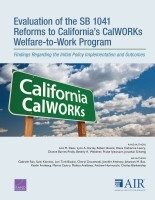| 来源类型 | Research Reports
|
| 规范类型 | 报告
|
| DOI | https://doi.org/10.7249/RR1348
|
| ISBN | 9780833095558
|
| 来源ID | RR-1348-CDSS
|
| Evaluation of the SB 1041 Reforms to California's CalWORKs Welfare-to-Work Program: Findings Regarding the Initial Policy Implementation and Outcomes |
| Lois M. Davis; Lynn A. Karoly; Robert Bozick; Diana Catherine Lavery; Dionne Barnes-Proby; Beverly A. Weidmer; Praise O. Iyiewuare; Jonathan Schweig; Gabriele Fain; Sami Kitmitto; et al.
|
| 发表日期 | 2016
|
| 出版年 | 2016
|
| 页码 | 352
|
| 语种 | 英语
|
| 结论 |
Experience with Implementation- The California Department of Social Services (CDSS) state-level workgroup planning process was seen as positive and inclusive, but the intensive and lengthy process contributed to the slow release of guidance to counties, creating implementation challenges.
- As of July 2015, most counties had completed the reengagement of participants with the short-term young child exemption. Eighty-six percent of counties reported having implemented the Family Stabilization program countywide, and 69 percent reported they had implemented the Expanded Subsidized Employment program countywide.
- Three-quarters of all county social services departments reported reaching out to individual directors or agency representatives in other county agencies to plan for or implement support services under SB 1041. Up to 60 percent of all the counties reported developing new or enhanced partnerships with providers of education, vocational education/job training, domestic violence services, substance abuse treatment, and mental health services.
- County administrators and caseworkers found the complexity of SB 1041 hindered its implementation, as did the time involved in administering the new welfare-to-work (WTW) 24-month time clock.
- Almost all counties (93 percent) reported that explaining SB 1041 to participants was a barrier to successful implementation.
Participant Indicators- Descriptive analyses of participant indicators show an increase in exemptions, no change in the sanction rate, and some increase in employment and earnings but do not confirm that these trends result from the SB 1041 changes.
- An empirical approach to estimate the causal effect of SB 1041 on participant outcomes suggests small changes up to two years after implementation. But, since SB 1041 reforms have not yet been fully implemented across all counties, strong effects on family and adult outcomes are not expected until more time has elapsed.
|
| 摘要 |
- As the initial product of a multiyear evaluation, this report with evaluation findings was not intended to lead to specific recommendations.
- But the findings do suggest there is scope for improving the implementation of time-clock rules across the counties and for ensuring caseworkers understand the rules.
- There is also a need for clearer guidance for CalWORKs participants on how to use the flexibility they have under SB 1041.
- Counties may further benefit from testing process improvements or other best practices and then disseminating effective approaches to other counties.
|
| 主题 | California
; Families
; Personal Responsibility and Work Opportunity Reconciliation Act of 1996
; Welfare Reform
|
| URL | https://www.rand.org/pubs/research_reports/RR1348.html
|
| 来源智库 | RAND Corporation (United States)
|
| 引用统计 |
|
| 资源类型 | 智库出版物
|
| 条目标识符 | http://119.78.100.153/handle/2XGU8XDN/108441
|
推荐引用方式
GB/T 7714 |
Lois M. Davis,Lynn A. Karoly,Robert Bozick,et al. Evaluation of the SB 1041 Reforms to California's CalWORKs Welfare-to-Work Program: Findings Regarding the Initial Policy Implementation and Outcomes. 2016.
|
|
文件名:
|
x1540239959414.jpg
|
|
格式:
|
JPEG
|

|
文件名:
|
RAND_RR1348.pdf
|
|
格式:
|
Adobe PDF
|
除非特别说明,本系统中所有内容都受版权保护,并保留所有权利。